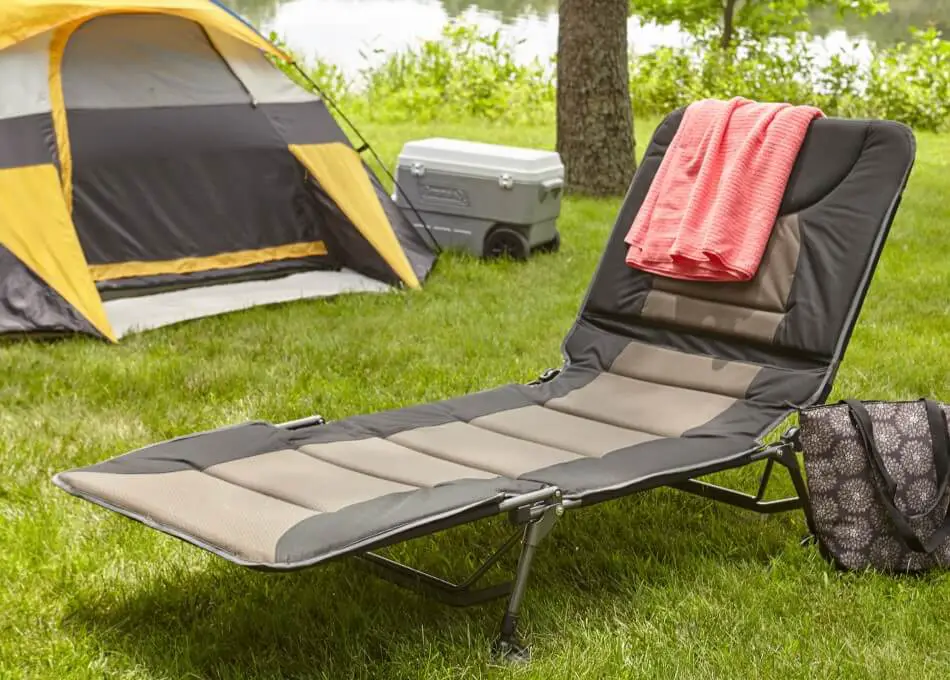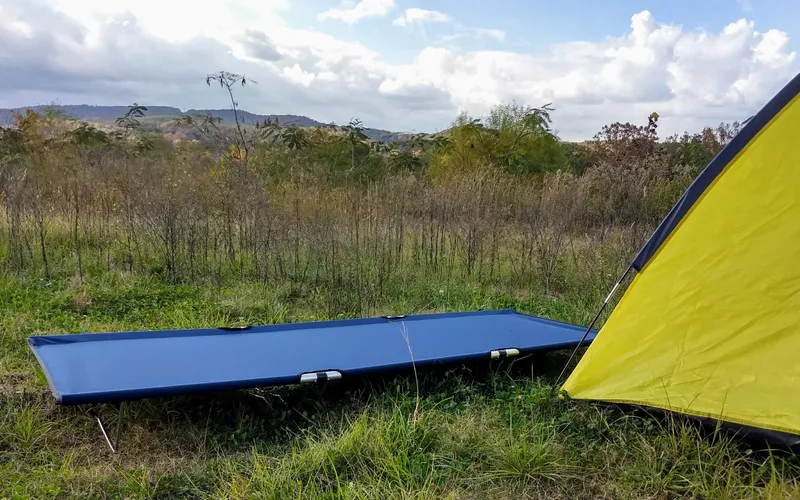When deciding on a cot vs. air mattress for camping, consider the outdoor temperature, sleeping position, storage, and space needed.
We have a comprehensive comparison to help you decide.
What is your camping style? Are you a side sleeper or a back sleeper? What are your personal preferences?
These and other questions will help us guide you to your most appropriate sleeping buddy, whether a blow-up bed or a portable cot.

Table of Contents
What Are Camping Cots?
A camping cot or camp bed is a small, transportable, light bed used when regular beds are unavailable or unsuitable.
It comprises a foldable metal or wood frame with nylon, polyester, linen, or canvas covering for lying on.
Camping cots are commonly used in emergencies, army camps, and leisure outdoor camping.
You might want to include a camping pillow and a foam mattress for prolonged camping periods for extra comfort.
The ideal camping cot should be easily washable and made of comfortable fabric, such as polyester or nylon.
Canvas material may be more durable but is usually very difficult to clean.
The cot’s frames should be lightweight, rust-resistant, durable, and easily foldable.
Most cots have aluminum frames in U or X-shaped designs.
I have the TETON Sports Camping Cot that I use inside my tent. It does take up a bit of space, but it gives me a great night’s sleep when using a pad on top.
Pros of Camping Cots
- Provide underneath storage space
- Provide a place to sit and dress up
- Rugged for all weather conditions
- Off the ground sleeping
Cons of Camping Cots
- Heavy and bulky to store and transport
- Allows heat loss
- Costly
An air mattress, blow-up bed, or airbed is an inflatable mattress usually made of polyvinyl chloride (PVC), although some are rubber.
Air mattresses are popular and affordable and come in many designs for use in RVs, at home, or in tents.
A portable air compressor or a hand-held pump inflates the airbeds.
Air mattresses can be deflated and folded into smaller sizes or shapes for easy storage.
Other handy airbed accessories include a repair kit, an air pump, and an optional chair sling.
Pros of Air Mattresses
- Portable and easy to store
- Have a bed-like comfort
- Adjustable firmness
Cons of Air Mattresses
- Must be inflated before use
- High risk of damage through tears and punctures
- Occupy too much tent space
- Overnight air leakage

Comparison: Cot vs. Air Mattress for Camping
Setup and Use
Foldable camping cots are the easiest to set up at camp.
Unfold the frames and lock them in place, and you’re set.
On the other hand, air mattresses must be unrolled and inflated before use.
If your valves are faulty or, even worse, if you forgot the air pump, you are in for a rough night.
Some self-inflating air mattresses use an internal electric pump to inflate/deflate the mattress.
However, the pumps can be as loud as a vacuum cleaner or even a hair dryer, which is undesirable.
Storage
Air mattresses can be thick and take up a lot of space in a tent.
In some cases, they may occupy too much space.
Camping cots may take up just as much space, but they offer under-the-bed storage space for your camping gear, such as hiking shoes.
Air mattresses are the easiest and most convenient to store or transport.
They deflate, fold, and put into their storage bags.
The process is made even easier when you have internal electric pumps to help with the deflation.
Air mattresses take up tiny trunk and storage space.
Camping cots have rigid frames that take up much trunk space even when folded.
They are heavy and bulky, and thus, except for a few, they may not be practical for backpacking or hiking.
Regarding storage and portability, most camping cots are best suited for RV and car camping.
Sleeping Style
Sleeping positions vary from individual to individual.
In the US, 74% of people sleep on their sides, 16% on their stomachs, and 10% on their backs.
Regardless of your preferred sleeping position, your sleeping system should offer comfort and support for a good night’s sleep and long-term health benefits.
For side sleepers, the sleeping surface should be medium firm for better conformity to their body shape without putting too much strain on their shoulders and hips.
An air mattress with medium firmness can provide a side sleeper with the necessary support and comfort.
The fabric in a camping cot forms a taut surface when you lie on it, which may not be ideal for side sleepers.
I have some challenges sleeping on my side when using the cot.
Putting an inflatable pad and sleeping bag in gives some cushioning when sleeping on the side.
Sleeping on your back is considered the best position since your spine is correctly aligned with your neck and head in a neutral position.
Therefore, you need a firm sleeping surface and a low-profile pillow to maintain this alignment.
A camping cot excels in this and is more tailored for back sleepers.
Stomach sleepers put a lot of strain on their spine and muscles.
It is essential to pick the right sleeping system to alleviate this problem.
An air mattress with a memory foam top layer is best, as the foam quickly conforms to one’s body without forgoing comfort.
Elevation from the Ground
Being too close to the ground compromises proper airflow and heat retention.
That’s why sleeping pads on the ground make poor sleeping systems for camping.
Cold weather means the ground is just as cold or even colder.
A sleeping system too close to the ground will be problematic.
An insulating material like a foam strip can be placed on top of the air mattress for double protection against the cold.
A self-insulated air mattress can be less bulky, but cold air might still enter the bed through the mattress’s vents.
Airbeds provide about a 3 to 4-inch elevation from the ground.
When it’s raining, water may pool under the tent, so an airbed may not offer enough protection against such discomfort.
Camping cots have heights varying from 4 to 22 inches, which is well off the ground.
The elevation allows for the much-needed airflow, which is especially useful for cooling you off during hot weather.
It also keeps you off water during rainy conditions but can exacerbate heat loss during cold weather conditions.
Over 80 percent of adults experience back pain at some point.
People ages 30 to 50 are the most affected by this problem.
It worsens when one puts too much strain on the back muscles.
Compared to a sleeping system like an airbed or sleeping pad, camping cots can help lessen the strain involved while standing up from ground level.
Size of Sleeping Systems
Air mattresses are the best design for a shared sleeping system.
They come in low-profile or raised styles and are available in many sizes, such as twin, queen, or king.
Conversely, camping cots are built primarily for one person’s use and thus may be impractical to share with another person.
But take note that double cots do exist.
However, if the tent space is big enough, cots are available in various sizes and heights.
Durability
Another critical factor to consider is the sleeping system’s durability.
Ideally, you would want one that will maintain its structural integrity during use, transportation, and storage and be long-lasting.
Air mattresses are generally not very durable.
They can easily get punctured by sticks or sharp objects, plus they tend to lose air overnight due to faulty valves, among other reasons.
An airbed with a thicker PVC layer can help avoid tears, seam splits, and general air leakages.
Some air mattresses utilize an inbuilt coil system to stabilize the mattress, improve lumbar support, and avoid sagging.
This feature prolongs the life of the airbed a little longer.
Camping cots are the most durable and sturdiest sleeping system.
They are made with aluminum frames and rugged fabrics for guaranteed longevity and strength.
You can also get a steel-framed one for extra sturdiness and durability.
Lubricate the moving parts of the frame to prevent squeaking.
Heat Loss/Retention
Air is a poor conductor of heat and works perfectly as a barrier to heat transfer through radiation or conductive means.
Air’s thermal resistance mostly depends on the thickness and height of the cavities involved—an increase in either results in an increase in heat transfer, primarily through convection.
In cold weather, the airbeds may not transfer too much heat from your body or vice versa.
Proper airflow is needed in hot weather to keep you cool throughout the night.
Air mattresses do little towards this as they don’t allow for adequate heat transfer away from the body.
An air mattress tends to be perfect for dry weather free from precipitation.
A pad with a high R-value placed on top of the airbed can help provide more insulation and cushioning.
The space left in camping cots allows for airflow, essential for heat loss during hot weather.
On the downside, you may experience the draft under the tent during cold weather.
To prevent this, use a bed cover that goes to the ground to keep the cold air off.
With very minor tweaks, camping cots offer the best all-weather sleeping system.
A foam mattress, sleeping bags, and/or wool blankets can help keep you warm.
Related Article: Sleeping Pad R-Value Explained
More Thoughts
Airbeds have been found to provide relief from back pain.
This is primarily due to their adjustable firmness, which can be customized for various body shapes, weights, sizes, and sleeping positions.
Moreover, airbeds made with VOC-free materials reduce the risk of allergies.
However, most air mattresses have a plastic odor caused by the PVC material, which may cause discomfort for some people.
Most air mattresses are made of plastic and tend to become squeaky and slide around with any body movement, unlike cots, which have stable support and don’t allow such movement.
Camping cots are designed similarly to regular beds.
As a result, it is easier to get in and out of them, sit on them, and even dress up while using them.
Additionally, some camping cots can be converted into benches for use outside of the tent, which can be quite convenient.
Furthermore, pockets are sewn into the cots to help with organization.

Final Thoughts
While camping hammocks, sleeping bags, and sleeping pads are good options, they have shortcomings compared to air mattresses or cots.
Hammocks are a great option for those who don’t have much space, and they provide a comfortable way to sleep off the ground.
Related Article: Can’t Decide on Camping Gear? Hammock or Tent – Make the Best Choice!
However, they don’t offer any insulation, so you’ll need a rainfly to stay dry if it rains.
One downside is that sleeping in a hammock can cause back pain, as your body sinks into the middle.
Hammocks are best suited for warm weather conditions or lounging during the daytime.
Some campers may choose to sleep directly on the tent floor using just a sleeping bag, but this can quickly become uncomfortable.
Sleeping pads are typically lighter and less bulky for storage and transportation, but they may require additional insulation for colder nights.
Investing in a high-quality sleeping pad can help to prevent the loss of body heat while sleeping.
Sleeping pads with an open-cell foam construction are particularly effective in providing comfort and boosting insulation.
The foam in the pad provides a firm surface to lie on, while the foam cells trap in air, providing additional cushioning and warmth.
A sleeping pad with an R-value (thermal resistance) of more than 5 is ideal for winter conditions.
The higher the R-value, the more insulation the pad offers.
As a single-use sleeping option, neither of these alternative sleeping systems can compete with an air mattress or a camping cot.
As such, any worthy debate should be a battle between the cots and the airbeds.
I prefer having both worlds with an inflatable sleeping pad on my cot. After trying many sleeping systems, this seems to be the best for me.
Good luck with your decision!
Enjoy living the outdoor life!!!
